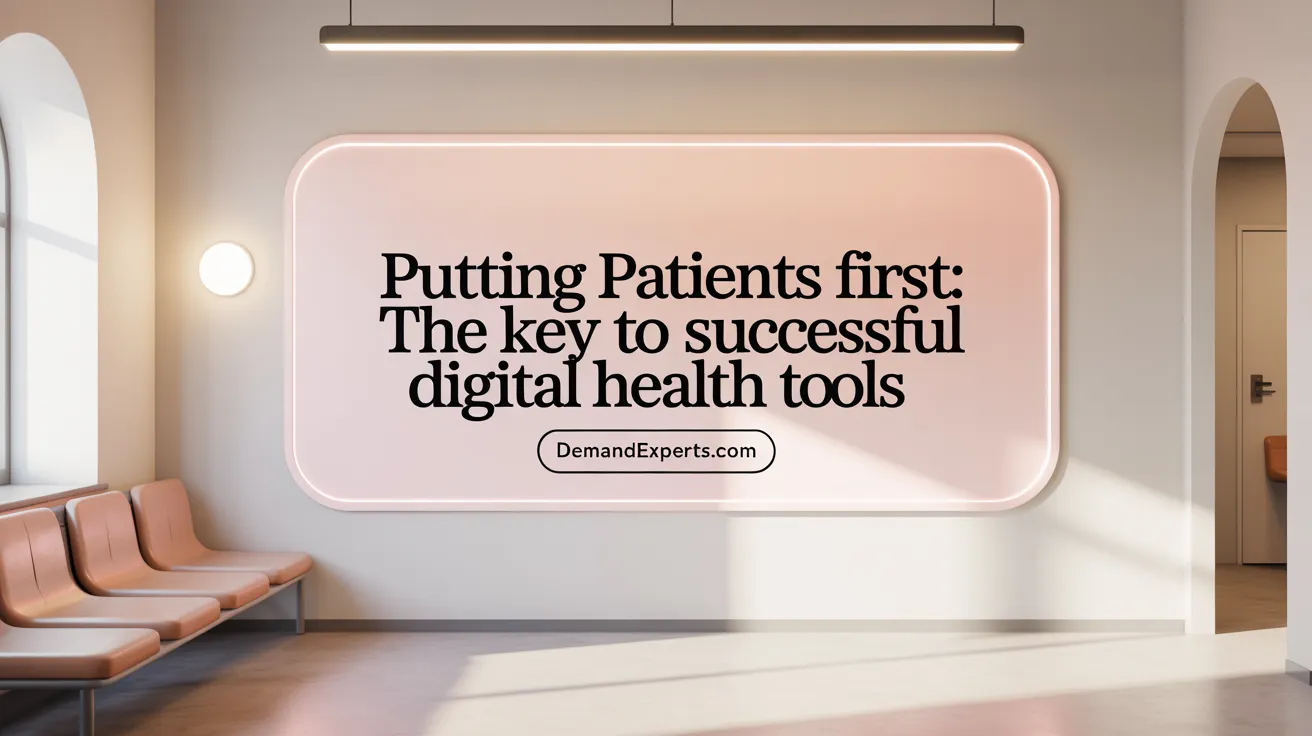Advancing Patient Engagement with Digital Innovation
Digital health technologies such as mobile apps, wearable devices, and telemedicine platforms have revolutionized patient engagement by offering tools for self-monitoring, improved communication, and personalized care management. Despite strong patient interest, sustained utilization remains a hurdle. This article explores how carefully designed, patient-focused digital platforms can overcome barriers and foster deeper engagement to improve health outcomes.
Understanding Patient Engagement in Digital Health

What is patient engagement and how do digital health tools facilitate it?
Patient engagement refers to the process of enabling and empowering patients to take an active role in managing their own healthcare. Digital health tools such as wearable devices and mobile applications play a crucial role in this process. These technologies allow patients to self-monitor their health metrics, encourage positive behavior changes, enhance their understanding of diagnoses and discharge plans, and facilitate ongoing, dynamic communication between patients and healthcare providers. By leveraging these tools, patients can become more informed and involved in decisions that affect their health outcomes.
What are the current trends in patient interest versus actual usage of these tools?
Despite a strong interest in digital health tools—claims show up to 66% of patients express willingness to use apps and wearable monitors for health improvement—actual usage and sustained engagement remain low. Retention rates drop significantly after initial use, with only about 27–30% of users continuing to engage with these tools over a 90-day period. This discrepancy is largely attributed to issues such as poor usability, lack of relevance to the patients’ specific needs, and insufficient involvement of patients in the design process of these technologies. Addressing these challenges by involving end-users in design and providing patient-centered interfaces could help bridge the gap between interest and sustained engagement.
The Importance of User-Centered and Patient-Centered Design

Why is involving patients in the design process crucial for digital health tools?
Involving patients in the development of digital health tools is essential to ensure that these technologies truly meet the needs of their users. When patients actively participate through focus groups, interviews, and iterative testing, the resulting solutions become more relevant, usable, and effective. This engagement addresses real-world challenges and user preferences rather than relying solely on expert assumptions. Consequently, patient involvement increases the likelihood that digital health tools will be consistently used and retained, overcoming the common low engagement rates seen in many digital health applications.
What are successful approaches to patient-centered design?
Successful patient-centered design strategies emphasize collaboration and rapid iteration. These include patient-led initiatives, where patients help define priorities and features, and crowd-sourcing feedback that gathers diverse viewpoints efficiently. Short iterative trials enable continuous refinement based on user input, speeding development timelines. Engaging with patient organizations fosters trust and ensures that solutions address specific community needs. Additionally, involving clinicians alongside patients integrates usability considerations from multiple perspectives, enhancing overall system effectiveness (Participatory design in digital health development).
User-centered design principles
User-centered design (UCD) involves embedding end-users throughout development to create health technologies that offer high functionality and usability. UCD prioritizes tailoring interfaces to minimize cognitive load and accessibility challenges, improving overall satisfaction. This approach has proven successful in applications designed for chronic disease management, where ongoing patient input guides feature development and usability testing, leading to tools that better support self-monitoring and health management.
Benefits of participatory design
Participatory design bridges the gap between technology developers, healthcare providers, and patients. By cultivating partnerships and inclusive co-creation, these designs produce higher quality, more usable digital health solutions that patients find meaningful and motivating. Such collaboration fosters sustained engagement, empowers users, and can lead to better health outcomes by ensuring that tools align with patient experiences, preferences, and daily routines (Engaging patients in digital health.
Integrating Clinician and Multistakeholder Collaboration

How does clinician involvement impact digital health platform design?
Clinicians play a crucial role as end-users in the design of digital health platforms. Their direct input ensures that these tools align with real-world clinical workflows and usability needs, enhancing overall system effectiveness. By involving clinicians early, design teams can identify practical features that address everyday challenges and reduce usability issues. This involvement promotes clinical relevance, facilitating better patient engagement and improving quality of care.
Why is a multistakeholder approach beneficial?
A multistakeholder approach involves collaboration among technology developers, clinicians, and patients throughout the development process. This partnership fosters co-creation, allowing digital health tools to better address the diverse needs and expectations of all users. Such collaborative design efforts result in higher-quality, more user-friendly digital health solutions that are more readily adopted across health systems. Integrating multiple perspectives also supports seamless workflow integration and promotes sustained patient engagement (clinician involvement in digital tool design, partnerships between developers, clinicians, and patients).
Collaborative partnerships in digital health
Effective digital health innovation relies on building and sustaining partnerships that actively include patients, clinicians, and technical teams. Methods such as user-centered design, participatory design, and iterative testing with all stakeholders ensure that the solutions developed are relevant, accessible, and practical. These partnerships help accelerate innovation while ensuring that new technologies truly serve end-users and healthcare goals (collaborative patient-provider relationships with technology, patient-centered digital health innovation.
Emphasizing collaboration across disciplines creates a patient-centered ecosystem where technological advances translate into meaningful health outcomes (enhancing patient engagement through design, improving usability of health technology.
Designing Inclusive and Accessible Digital Platforms
How can digital health tools be designed to include diverse patient populations?
Designing digital health tools for diversity and inclusion requires thoughtful accessibility features and tailored user support. Key accessibility enhancements include adjustable font sizes to accommodate visual impairments, high-contrast color schemes for better readability, simple and clear language, and voice commands to assist users with motor or vision challenges. Multilingual support ensures that non-native speakers can navigate digital tools effectively (Digital health platforms, Inclusive design in digital health tools, Visual accessibility in mHealth apps).
To bridge digital and health literacy gaps, particularly among older adults and vulnerable groups, patient education and ongoing support are vital. This includes providing user-friendly interfaces and instructional resources that empower patients to confidently engage with their health data and management tools (Importance of digital literacy in healthcare, User-friendly healthcare apps, Digital health and patient engagement.
What strategies address disparities in access and usability?
Addressing disparities in access involves integrating co-creation and participatory design methodologies that actively involve vulnerable and underrepresented populations. This approach ensures that cultural, linguistic, and functional needs are comprehensively considered throughout development (Co-creation in digital health development, Participatory design in digital health development, Patient-led design approach.
Virtual collaboration tools facilitate broad engagement by reducing geographic and physical barriers, enabling diverse stakeholders to contribute insights and feedback (Virtual collaboration for diverse patient engagement, Engagement with patient organizations.
Partnerships with community organizations further enhance inclusion by tailoring solutions to local contexts and promoting adoption among marginalized groups (Community health initiatives, Multistakeholder approach to digital health).
Such inclusive design processes lead to digital health platforms that are equitable, user-centered, and more likely to sustain engagement across all patient populations (User-centered design in healthcare software, Patient-centered digital health innovation.
Enhancing User Experience (UX) and Usability in Healthcare Apps
What are essential UX design principles for healthcare apps?
Effective healthcare apps prioritize user-friendly design to accommodate diverse users, from younger patients to older adults. Key principles include:
- Simple navigation: Clear menus and intuitive pathways help users find information quickly without confusion (User-Friendly Healthcare Apps, UI/UX Design Principles, Healthcare app design best practices).
- Fast onboarding: Quick, straightforward registration and setup processes encourage initial usage (Healthcare app design best practices.
- Clear visual hierarchy: Important elements are emphasized using size, color, and placement to guide users smoothly (User-centered design in healthcare software).
- Accessibility: Features such as large fonts, high-contrast screens, voice commands, and multilingual support cater to age, ability, and language diversity (Barriers faced by older adults in mHealth, User-Friendly Healthcare Apps, Inclusive design in digital health tools.
- Trust and security: Transparent privacy policies, secure login methods like two-factor authentication and biometric verification, and compliance with regulations such as HIPAA and GDPR build user confidence (Protecting Health Data, Healthcare app legal compliance, Privacy practices in healthcare apps).
What security and privacy considerations are critical?
Healthcare apps handle sensitive data, so robust security is essential. This includes encryption, automatic logout, disabling sensitive notifications, and dedicated confidential screens. These measures not only protect users but also foster trust vital for continued engagement (Protecting Health Data, HIPAA and GDPR compliance, Healthcare app legal compliance.
What common UX mistakes should be avoided?
Avoiding pitfalls is as important as applying best practices. Common mistakes include:
- Cluttered dashboards: Overcrowded screens overwhelm users and impede task completion (Common Healthcare UX Mistakes.
- Complex language: Medical jargon or complicated wording alienate users with limited health literacy (Designing Healthcare Apps, Importance of digital literacy in healthcare).
- Lengthy registration forms: Excessive data entry discourages sign-ups and increases drop-off (User-Centered Healthcare Software Design.
How can continuous improvement be ensured?
Ongoing usability testing, gathering user feedback, analyzing session data, and employing A/B testing help identify issues and optimize experience continually. This iterative process ensures apps remain relevant, effective, and user-centric over time (A/B testing in digital health, Healthcare App Usability Testing, Iterative co-creation processes.
Personalization and Human-Centered Technology Approaches
How does personalization improve patient engagement?
Personalization in digital health tailors educational materials, reminders, and communications specifically to patients' unique health conditions, preferences, and learning styles. This custom approach makes digital tools more relevant and engaging for users, encouraging them to interact consistently and take an active role in managing their health. By focusing on what matters most to each individual, personalized experiences enhance health literacy, empower patients with understanding their care, and support better adherence to treatment plans (Importance of digital literacy in healthcare, Personalization in digital health platforms, Personalization in mental health apps).
What is the role of human-centered technology in digital health?
Human-centered technology integrates user-friendly digital platforms with personal support from healthcare professionals and peer communities. This blend creates a trusted environment where patients feel emotionally connected, supported, and motivated. The human element—whether through direct communication or social encouragement—reinforces the digital experience, promoting sustained engagement and ultimately leading to improved health outcomes (Human-centered technology approach, Peer community support, Clinician-patient collaboration via digital tools.
Combining personalization with human support boosts motivation and adherence
By merging tailored digital content with meaningful human interaction, patients receive both the information and emotional encouragement needed to maintain positive health behaviors. This approach addresses common barriers like disengagement and low usability, making health management both accessible and motivating. Patients benefit from a supportive ecosystem that adapts to their needs, promoting long-term adherence and better overall care (Benefits of digital health tools for patient self-management, Improving usability of health technology, Enhancing patient motivation and adherence).
Leveraging Digital Platforms and Emerging Technologies
Telemedicine and Remote Monitoring
Telemedicine stands out as a pivotal digital technology enhancing patient engagement by offering virtual consultations that greatly increase healthcare accessibility and convenience. This is especially beneficial for patients in remote areas or those facing mobility challenges. By enabling real-time virtual visits, telemedicine reduces wait times and barriers to care, fostering continuous, proactive health management. Remote monitoring tools complement telemedicine by allowing patients to track vital signs and chronic conditions from home, which encourages self-management and timely intervention. For more about patient engagement with telehealth, see best practices and guidelines.
AI and Data Analytics
Artificial intelligence (AI) and advanced data analytics play transformative roles in personalizing healthcare. AI-powered systems analyze patient data to provide predictive diagnostics, personalized treatment recommendations, and early detection of health issues. These technologies enable clinicians to deliver more targeted care while empowering patients with tailored health insights. Additionally, AI-driven communication tools, such as chatbots and automated reminders, enhance engagement by providing personalized messaging and delivering timely interventions.
Integration with Provider Systems
Seamless integration of digital platforms with healthcare provider systems, including electronic health records (EHRs) and patient portals, is crucial for efficient care coordination. This integration facilitates real-time data sharing, comprehensive management of patient health data, and smoother communication between patients and providers. It also supports secure access to medical records, appointment scheduling, medication adherence tracking, and remote monitoring data, thereby enhancing patient-centered care and engagement. For detailed features of an effective patient engagement platform, see 5 Must-Have Features of an Effective Patient Platform.
Future Trends Shaping Digital Patient Engagement
Emerging trends are shaping a more connected and personalized digital health landscape. These include hyper-personalization of health content through AI, synchronization with wearable devices for continuous health monitoring, and immersive VR/AR technologies for health education and behavior change. These innovations aim to create more interactive, engaging, and effective patient experiences that promote sustained engagement and improved health outcomes.
Ensuring Privacy, Security, and Compliance
Why is privacy and security crucial in digital health tools?
Digital health tools manage sensitive patient data, which demands robust security measures to protect information from unauthorized access and breaches. Encryption, multi-factor authentication such as biometric verification, and strict adherence to regulations like HIPAA and GDPR are essential to safeguard personal health information. By implementing these protections, digital platforms reduce patients' concerns about data misuse, fostering greater trust and encouraging engagement with the technology (Healthcare App Legal Compliance, Protecting Health Data.
How do regulations influence digital platform design?
Regulatory frameworks require platforms to ensure data protection, obtain informed user consent, and facilitate secure communications. This leads to design features such as automatic session logout, disabling notifications of sensitive information, and dedicated confidential content screens. Platforms must integrate these rules seamlessly to remain compliant while maintaining patient-friendly user experiences. Non-compliance risks penalties and loss of patient confidence, so regulatory adherence directly shapes both the technical and UX design of digital health solutions (HIPAA and GDPR compliance, Healthcare App Security Measures, Data Privacy and Consent Management).
What data protection measures are implemented?
Key data protection strategies include:
- Encryption of data at rest and in transit
- Use of multi-factor authentication for secure logins
- Clear privacy policies and consent management
- Regular monitoring and incident detection
- Secure cloud storage with role-based access control
These measures work together to ensure patients’ information remains confidential and secure throughout digital interactions (Privacy Practices in Healthcare Apps, Healthcare Security and Compliance.
How does building patient trust impact engagement?
Trust built through transparent privacy practices and strong security encourages patients to use digital tools actively and continuously. Personalization combined with clear communication about data use can alleviate privacy concerns (Importance of digital literacy in healthcare. When patients feel their information is safe, they are more likely to engage in self-monitoring, share accurate data, and collaborate openly with healthcare providers, leading to better health outcomes (Improving patient engagement through design, Digital health and patient engagement.
Measuring and Sustaining Patient Engagement
How is patient engagement measured in digital health?
Patient engagement in digital health is commonly measured through a combination of system usage metrics and multidimensional engagement assessments. Basic approaches track behaviors such as app usage frequency, session duration, and feature utilization. More nuanced methodologies evaluate affective (emotional involvement), cognitive (attention and understanding), and behavioral (active participation) aspects. For example, validated instruments like the Digital Behaviour Change Intervention Engagement Scale offer insights into diverse facets of engagement, though comprehensive, standardized tools are still evolving. See also Conceptualisation of user engagement.
Why is ongoing evaluation important?
Ongoing assessment is essential to capture real-time feedback on usability, relevance, and effectiveness, which influences patient adherence and health outcomes. Persistent evaluation identifies barriers such as declining interest, usability challenges, or insufficient personalization. It helps developers detect gaps early, maintaining alignment with patient needs and behavioral patterns. This continuous monitoring fosters trust and supports iterative improvements that keep users invested. See more about User-centered design in digital health and Human-centered design in digital medicine.
What strategies support continuous improvement in patient engagement?
Sustaining engagement relies on iterative design guided by regular user feedback collected via surveys, interviews, and usage analytics. Personalizing content delivery and communication timing increases motivation and reduces fatigue. Engaging a diverse user base, including clinicians and vulnerable groups, ensures tools serve broad needs. Data-driven insights allow tailoring interventions dynamically, while participatory design methodologies—such as co-creation with patients—facilitate meaningful involvement and enhance usability. Clinician input is also vital in refining workflows and information presentation, further supporting long-term adherence and impact. For further guidance, see Participatory design for digital health solutions, Clinician involvement in digital tool design, and Patient-centered digital health innovation.
Towards Patient-Centric Digital Health Platforms
Designing digital health platforms with a patient-focused approach requires comprehensive attention to user needs, inclusion, usability, security, and continuous evaluation. By integrating patient and clinician insights, embracing personalization, and fostering trust through privacy and human-centered design, healthcare systems can unlock the full potential of digital engagement. This will ultimately empower patients, enhance adherence, reduce health disparities, and improve outcomes in the evolving landscape of digital healthcare.
Advancing Patient Engagement with Digital Innovation
Digital health technologies such as mobile apps, wearable devices, and telemedicine platforms have revolutionized patient engagement by offering tools for self-monitoring, improved communication, and personalized care management. Despite strong patient interest, sustained utilization remains a hurdle. This article explores how carefully designed, patient-focused digital platforms can overcome barriers and foster deeper engagement to improve health outcomes.
Understanding Patient Engagement in Digital Health

What is patient engagement and how do digital health tools facilitate it?
Patient engagement refers to the process of enabling and empowering patients to take an active role in managing their own healthcare. Digital health tools such as wearable devices and mobile applications play a crucial role in this process. These technologies allow patients to self-monitor their health metrics, encourage positive behavior changes, enhance their understanding of diagnoses and discharge plans, and facilitate ongoing, dynamic communication between patients and healthcare providers. By leveraging these tools, patients can become more informed and involved in decisions that affect their health outcomes.
What are the current trends in patient interest versus actual usage of these tools?
Despite a strong interest in digital health tools—claims show up to 66% of patients express willingness to use apps and wearable monitors for health improvement—actual usage and sustained engagement remain low. Retention rates drop significantly after initial use, with only about 27–30% of users continuing to engage with these tools over a 90-day period. This discrepancy is largely attributed to issues such as poor usability, lack of relevance to the patients’ specific needs, and insufficient involvement of patients in the design process of these technologies. Addressing these challenges by involving end-users in design and providing patient-centered interfaces could help bridge the gap between interest and sustained engagement.
The Importance of User-Centered and Patient-Centered Design

Why is involving patients in the design process crucial for digital health tools?
Involving patients in the development of digital health tools is essential to ensure that these technologies truly meet the needs of their users. When patients actively participate through focus groups, interviews, and iterative testing, the resulting solutions become more relevant, usable, and effective. This engagement addresses real-world challenges and user preferences rather than relying solely on expert assumptions. Consequently, patient involvement increases the likelihood that digital health tools will be consistently used and retained, overcoming the common low engagement rates seen in many digital health applications.
What are successful approaches to patient-centered design?
Successful patient-centered design strategies emphasize collaboration and rapid iteration. These include patient-led initiatives, where patients help define priorities and features, and crowd-sourcing feedback that gathers diverse viewpoints efficiently. Short iterative trials enable continuous refinement based on user input, speeding development timelines. Engaging with patient organizations fosters trust and ensures that solutions address specific community needs. Additionally, involving clinicians alongside patients integrates usability considerations from multiple perspectives, enhancing overall system effectiveness (Participatory design in digital health development).
User-centered design principles
User-centered design (UCD) involves embedding end-users throughout development to create health technologies that offer high functionality and usability. UCD prioritizes tailoring interfaces to minimize cognitive load and accessibility challenges, improving overall satisfaction. This approach has proven successful in applications designed for chronic disease management, where ongoing patient input guides feature development and usability testing, leading to tools that better support self-monitoring and health management.
Benefits of participatory design
Participatory design bridges the gap between technology developers, healthcare providers, and patients. By cultivating partnerships and inclusive co-creation, these designs produce higher quality, more usable digital health solutions that patients find meaningful and motivating. Such collaboration fosters sustained engagement, empowers users, and can lead to better health outcomes by ensuring that tools align with patient experiences, preferences, and daily routines (Engaging patients in digital health.
Integrating Clinician and Multistakeholder Collaboration

How does clinician involvement impact digital health platform design?
Clinicians play a crucial role as end-users in the design of digital health platforms. Their direct input ensures that these tools align with real-world clinical workflows and usability needs, enhancing overall system effectiveness. By involving clinicians early, design teams can identify practical features that address everyday challenges and reduce usability issues. This involvement promotes clinical relevance, facilitating better patient engagement and improving quality of care.
Why is a multistakeholder approach beneficial?
A multistakeholder approach involves collaboration among technology developers, clinicians, and patients throughout the development process. This partnership fosters co-creation, allowing digital health tools to better address the diverse needs and expectations of all users. Such collaborative design efforts result in higher-quality, more user-friendly digital health solutions that are more readily adopted across health systems. Integrating multiple perspectives also supports seamless workflow integration and promotes sustained patient engagement (clinician involvement in digital tool design, partnerships between developers, clinicians, and patients).
Collaborative partnerships in digital health
Effective digital health innovation relies on building and sustaining partnerships that actively include patients, clinicians, and technical teams. Methods such as user-centered design, participatory design, and iterative testing with all stakeholders ensure that the solutions developed are relevant, accessible, and practical. These partnerships help accelerate innovation while ensuring that new technologies truly serve end-users and healthcare goals (collaborative patient-provider relationships with technology, patient-centered digital health innovation.
Emphasizing collaboration across disciplines creates a patient-centered ecosystem where technological advances translate into meaningful health outcomes (enhancing patient engagement through design, improving usability of health technology.
Designing Inclusive and Accessible Digital Platforms
How can digital health tools be designed to include diverse patient populations?
Designing digital health tools for diversity and inclusion requires thoughtful accessibility features and tailored user support. Key accessibility enhancements include adjustable font sizes to accommodate visual impairments, high-contrast color schemes for better readability, simple and clear language, and voice commands to assist users with motor or vision challenges. Multilingual support ensures that non-native speakers can navigate digital tools effectively (Digital health platforms, Inclusive design in digital health tools, Visual accessibility in mHealth apps).
To bridge digital and health literacy gaps, particularly among older adults and vulnerable groups, patient education and ongoing support are vital. This includes providing user-friendly interfaces and instructional resources that empower patients to confidently engage with their health data and management tools (Importance of digital literacy in healthcare, User-friendly healthcare apps, Digital health and patient engagement.
What strategies address disparities in access and usability?
Addressing disparities in access involves integrating co-creation and participatory design methodologies that actively involve vulnerable and underrepresented populations. This approach ensures that cultural, linguistic, and functional needs are comprehensively considered throughout development (Co-creation in digital health development, Participatory design in digital health development, Patient-led design approach.
Virtual collaboration tools facilitate broad engagement by reducing geographic and physical barriers, enabling diverse stakeholders to contribute insights and feedback (Virtual collaboration for diverse patient engagement, Engagement with patient organizations.
Partnerships with community organizations further enhance inclusion by tailoring solutions to local contexts and promoting adoption among marginalized groups (Community health initiatives, Multistakeholder approach to digital health).
Such inclusive design processes lead to digital health platforms that are equitable, user-centered, and more likely to sustain engagement across all patient populations (User-centered design in healthcare software, Patient-centered digital health innovation.
Enhancing User Experience (UX) and Usability in Healthcare Apps
What are essential UX design principles for healthcare apps?
Effective healthcare apps prioritize user-friendly design to accommodate diverse users, from younger patients to older adults. Key principles include:
- Simple navigation: Clear menus and intuitive pathways help users find information quickly without confusion (User-Friendly Healthcare Apps, UI/UX Design Principles, Healthcare app design best practices).
- Fast onboarding: Quick, straightforward registration and setup processes encourage initial usage (Healthcare app design best practices.
- Clear visual hierarchy: Important elements are emphasized using size, color, and placement to guide users smoothly (User-centered design in healthcare software).
- Accessibility: Features such as large fonts, high-contrast screens, voice commands, and multilingual support cater to age, ability, and language diversity (Barriers faced by older adults in mHealth, User-Friendly Healthcare Apps, Inclusive design in digital health tools.
- Trust and security: Transparent privacy policies, secure login methods like two-factor authentication and biometric verification, and compliance with regulations such as HIPAA and GDPR build user confidence (Protecting Health Data, Healthcare app legal compliance, Privacy practices in healthcare apps).
What security and privacy considerations are critical?
Healthcare apps handle sensitive data, so robust security is essential. This includes encryption, automatic logout, disabling sensitive notifications, and dedicated confidential screens. These measures not only protect users but also foster trust vital for continued engagement (Protecting Health Data, HIPAA and GDPR compliance, Healthcare app legal compliance.
What common UX mistakes should be avoided?
Avoiding pitfalls is as important as applying best practices. Common mistakes include:
- Cluttered dashboards: Overcrowded screens overwhelm users and impede task completion (Common Healthcare UX Mistakes.
- Complex language: Medical jargon or complicated wording alienate users with limited health literacy (Designing Healthcare Apps, Importance of digital literacy in healthcare).
- Lengthy registration forms: Excessive data entry discourages sign-ups and increases drop-off (User-Centered Healthcare Software Design.
How can continuous improvement be ensured?
Ongoing usability testing, gathering user feedback, analyzing session data, and employing A/B testing help identify issues and optimize experience continually. This iterative process ensures apps remain relevant, effective, and user-centric over time (A/B testing in digital health, Healthcare App Usability Testing, Iterative co-creation processes.
Personalization and Human-Centered Technology Approaches
How does personalization improve patient engagement?
Personalization in digital health tailors educational materials, reminders, and communications specifically to patients' unique health conditions, preferences, and learning styles. This custom approach makes digital tools more relevant and engaging for users, encouraging them to interact consistently and take an active role in managing their health. By focusing on what matters most to each individual, personalized experiences enhance health literacy, empower patients with understanding their care, and support better adherence to treatment plans (Importance of digital literacy in healthcare, Personalization in digital health platforms, Personalization in mental health apps).
What is the role of human-centered technology in digital health?
Human-centered technology integrates user-friendly digital platforms with personal support from healthcare professionals and peer communities. This blend creates a trusted environment where patients feel emotionally connected, supported, and motivated. The human element—whether through direct communication or social encouragement—reinforces the digital experience, promoting sustained engagement and ultimately leading to improved health outcomes (Human-centered technology approach, Peer community support, Clinician-patient collaboration via digital tools.
Combining personalization with human support boosts motivation and adherence
By merging tailored digital content with meaningful human interaction, patients receive both the information and emotional encouragement needed to maintain positive health behaviors. This approach addresses common barriers like disengagement and low usability, making health management both accessible and motivating. Patients benefit from a supportive ecosystem that adapts to their needs, promoting long-term adherence and better overall care (Benefits of digital health tools for patient self-management, Improving usability of health technology, Enhancing patient motivation and adherence).
Leveraging Digital Platforms and Emerging Technologies
Telemedicine and Remote Monitoring
Telemedicine stands out as a pivotal digital technology enhancing patient engagement by offering virtual consultations that greatly increase healthcare accessibility and convenience. This is especially beneficial for patients in remote areas or those facing mobility challenges. By enabling real-time virtual visits, telemedicine reduces wait times and barriers to care, fostering continuous, proactive health management. Remote monitoring tools complement telemedicine by allowing patients to track vital signs and chronic conditions from home, which encourages self-management and timely intervention. For more about patient engagement with telehealth, see best practices and guidelines.
AI and Data Analytics
Artificial intelligence (AI) and advanced data analytics play transformative roles in personalizing healthcare. AI-powered systems analyze patient data to provide predictive diagnostics, personalized treatment recommendations, and early detection of health issues. These technologies enable clinicians to deliver more targeted care while empowering patients with tailored health insights. Additionally, AI-driven communication tools, such as chatbots and automated reminders, enhance engagement by providing personalized messaging and delivering timely interventions.
Integration with Provider Systems
Seamless integration of digital platforms with healthcare provider systems, including electronic health records (EHRs) and patient portals, is crucial for efficient care coordination. This integration facilitates real-time data sharing, comprehensive management of patient health data, and smoother communication between patients and providers. It also supports secure access to medical records, appointment scheduling, medication adherence tracking, and remote monitoring data, thereby enhancing patient-centered care and engagement. For detailed features of an effective patient engagement platform, see 5 Must-Have Features of an Effective Patient Platform.
Future Trends Shaping Digital Patient Engagement
Emerging trends are shaping a more connected and personalized digital health landscape. These include hyper-personalization of health content through AI, synchronization with wearable devices for continuous health monitoring, and immersive VR/AR technologies for health education and behavior change. These innovations aim to create more interactive, engaging, and effective patient experiences that promote sustained engagement and improved health outcomes.
Ensuring Privacy, Security, and Compliance
Why is privacy and security crucial in digital health tools?
Digital health tools manage sensitive patient data, which demands robust security measures to protect information from unauthorized access and breaches. Encryption, multi-factor authentication such as biometric verification, and strict adherence to regulations like HIPAA and GDPR are essential to safeguard personal health information. By implementing these protections, digital platforms reduce patients' concerns about data misuse, fostering greater trust and encouraging engagement with the technology (Healthcare App Legal Compliance, Protecting Health Data.
How do regulations influence digital platform design?
Regulatory frameworks require platforms to ensure data protection, obtain informed user consent, and facilitate secure communications. This leads to design features such as automatic session logout, disabling notifications of sensitive information, and dedicated confidential content screens. Platforms must integrate these rules seamlessly to remain compliant while maintaining patient-friendly user experiences. Non-compliance risks penalties and loss of patient confidence, so regulatory adherence directly shapes both the technical and UX design of digital health solutions (HIPAA and GDPR compliance, Healthcare App Security Measures, Data Privacy and Consent Management).
What data protection measures are implemented?
Key data protection strategies include:
- Encryption of data at rest and in transit
- Use of multi-factor authentication for secure logins
- Clear privacy policies and consent management
- Regular monitoring and incident detection
- Secure cloud storage with role-based access control
These measures work together to ensure patients’ information remains confidential and secure throughout digital interactions (Privacy Practices in Healthcare Apps, Healthcare Security and Compliance.
How does building patient trust impact engagement?
Trust built through transparent privacy practices and strong security encourages patients to use digital tools actively and continuously. Personalization combined with clear communication about data use can alleviate privacy concerns (Importance of digital literacy in healthcare. When patients feel their information is safe, they are more likely to engage in self-monitoring, share accurate data, and collaborate openly with healthcare providers, leading to better health outcomes (Improving patient engagement through design, Digital health and patient engagement.
Measuring and Sustaining Patient Engagement
How is patient engagement measured in digital health?
Patient engagement in digital health is commonly measured through a combination of system usage metrics and multidimensional engagement assessments. Basic approaches track behaviors such as app usage frequency, session duration, and feature utilization. More nuanced methodologies evaluate affective (emotional involvement), cognitive (attention and understanding), and behavioral (active participation) aspects. For example, validated instruments like the Digital Behaviour Change Intervention Engagement Scale offer insights into diverse facets of engagement, though comprehensive, standardized tools are still evolving. See also Conceptualisation of user engagement.
Why is ongoing evaluation important?
Ongoing assessment is essential to capture real-time feedback on usability, relevance, and effectiveness, which influences patient adherence and health outcomes. Persistent evaluation identifies barriers such as declining interest, usability challenges, or insufficient personalization. It helps developers detect gaps early, maintaining alignment with patient needs and behavioral patterns. This continuous monitoring fosters trust and supports iterative improvements that keep users invested. See more about User-centered design in digital health and Human-centered design in digital medicine.
What strategies support continuous improvement in patient engagement?
Sustaining engagement relies on iterative design guided by regular user feedback collected via surveys, interviews, and usage analytics. Personalizing content delivery and communication timing increases motivation and reduces fatigue. Engaging a diverse user base, including clinicians and vulnerable groups, ensures tools serve broad needs. Data-driven insights allow tailoring interventions dynamically, while participatory design methodologies—such as co-creation with patients—facilitate meaningful involvement and enhance usability. Clinician input is also vital in refining workflows and information presentation, further supporting long-term adherence and impact. For further guidance, see Participatory design for digital health solutions, Clinician involvement in digital tool design, and Patient-centered digital health innovation.
Towards Patient-Centric Digital Health Platforms
Designing digital health platforms with a patient-focused approach requires comprehensive attention to user needs, inclusion, usability, security, and continuous evaluation. By integrating patient and clinician insights, embracing personalization, and fostering trust through privacy and human-centered design, healthcare systems can unlock the full potential of digital engagement. This will ultimately empower patients, enhance adherence, reduce health disparities, and improve outcomes in the evolving landscape of digital healthcare.






